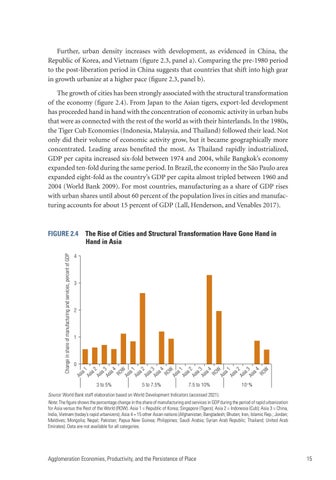Further, urban density increases with development, as evidenced in China, the Republic of Korea, and Vietnam (figure 2.3, panel a). Comparing the pre-1980 period to the post-liberation period in China suggests that countries that shift into high gear in growth urbanize at a higher pace (figure 2.3, panel b). The growth of cities has been strongly associated with the structural transformation of the economy (figure 2.4). From Japan to the Asian tigers, export-led development has proceeded hand in hand with the concentration of economic activity in urban hubs that were as connected with the rest of the world as with their hinterlands. In the 1980s, the Tiger Cub Economies (Indonesia, Malaysia, and Thailand) followed their lead. Not only did their volume of economic activity grow, but it became geographically more concentrated. Leading areas benefited the most. As Thailand rapidly industrialized, GDP per capita increased six-fold between 1974 and 2004, while Bangkok’s economy expanded ten-fold during the same period. In Brazil, the economy in the São Paulo area expanded eight-fold as the country’s GDP per capita almost tripled between 1960 and 2004 (World Bank 2009). For most countries, manufacturing as a share of GDP rises with urban shares until about 60 percent of the population lives in cities and manufacturing accounts for about 15 percent of GDP (Lall, Henderson, and Venables 2017).
The Rise of Cities and Structural Transformation Have Gone Hand in Hand in Asia
4
3
2
1
0
As ia 1 As ia 2 As ia As 3 ia 4 RO W As ia 1 As ia 2 As ia As 3 ia 4 RO W As ia 1 As ia 2 As ia As 3 ia 4 RO W As ia 1 As ia 2 As ia As 3 ia 4 RO W
Change in share of manufacturing and services, percent of GDP
FIGURE 2.4
3 to 5%
5 to 7.5%
7.5 to 10%
10+%
Source: World Bank staff elaboration based on World Development Indicators (accessed 2021). Note: The figure shows the percentage change in the share of manufacturing and services in GDP during the period of rapid urbanization for Asia versus the Rest of the World (ROW). Asia 1 = Republic of Korea; Singapore (Tigers); Asia 2 = Indonesia (Cub); Asia 3 = China, India, Vietnam (today’s rapid urbanizers); Asia 4 = 15 other Asian nations (Afghanistan; Bangladesh; Bhutan; Iran, Islamic Rep.; Jordan; Maldives; Mongolia; Nepal; Pakistan; Papua New Guinea; Philippines; Saudi Arabia; Syrian Arab Republic; Thailand; United Arab Emirates). Data are not available for all categories.
Agglomeration Economies, Productivity, and the Persistence of Place 15

